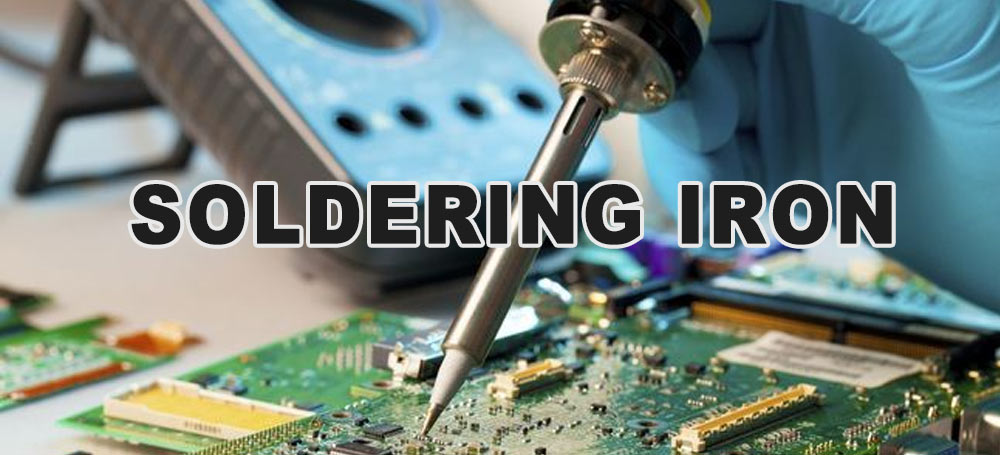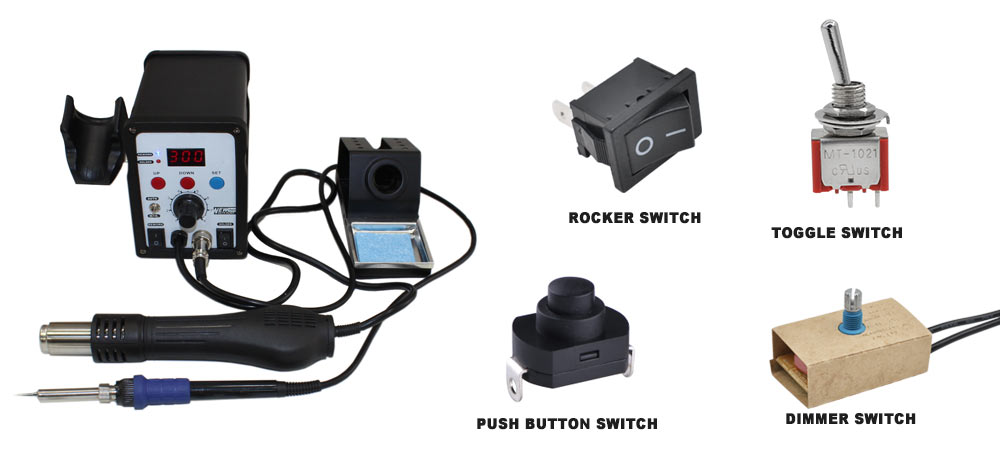What is a soldering iron?
A soldering iron is a tool used to heat a metal element, called a tip or bit, to a high temperature in order to melt and join together two pieces of metal, typically electrical wires or electronic components.
The melted metal, called solder, solidifies and forms a strong electrical connection between the two pieces. Soldering irons can come in a variety of sizes and shapes, with different temperature ranges and power capabilities to accommodate different types of soldering tasks. They are commonly used in electronics, jewellery-making, plumbing, and other metalworking applications.

Soldering Iron Types
There are several types of soldering irons available on the market, each with their own advantages and disadvantages:
Soldering pencil:
This is the most common type of soldering iron, and it is typically used for electronic circuit board work. It has a pointed tip and a thin heating element, making it easy to control the heat and precision.
Soldering gun:
This type of soldering iron has a larger heating element and is used for larger workpieces. It heats up quickly and is easy to use, but it is not as precise as a soldering pencil.
Soldering station:
This is a more advanced type of soldering iron that comes with a control unit and adjustable temperature settings. It is ideal for more complex projects that require different temperature levels.
Cordless soldering iron:
This type of soldering iron is battery-powered and portable, making it ideal for outdoor projects or situations where electricity is not available.
Butane soldering iron:
This type of soldering iron uses butane gas as a fuel source and is also portable. It is ideal for outdoor projects or situations where electricity is not available, but it is not as precise as a soldering pencil or soldering station.
Hot air soldering iron:
This type of soldering iron uses hot air to melt the solder, making it ideal for delicate projects that require precision.
Each type of soldering iron has its own strengths and weaknesses, so it’s important to choose the one that is best suited for your specific needs.

How a soldering iron work?
A soldering iron works by using an electrical current to heat up a metal tip or bit to a temperature high enough to melt the solder. The soldering iron is connected to a power source, such as a wall outlet or battery, and the current flows through the heating element of the iron, which is usually made of a resistive material like ceramic.
As the current flows through the heating element, it generates heat which is transferred to the metal tip. The tip is usually made of copper or iron, which have good thermal conductivity, and is coated with a thin layer of a material like nickel or chromium to prevent oxidation and corrosion.
When the metal tip reaches the desired temperature, it is brought into contact with the metal parts to be joined. The heat from the tip melts the solder, which is typically a mixture of lead and tin, and the liquid solder flows into the joint between the two pieces of metal, forming a strong, electrically conductive bond as it cools and solidifies.
The temperature of the soldering iron can be controlled using a thermostat or rheostat, which regulates the amount of current flowing through the heating element. Different types of soldering irons have different temperature ranges and power capabilities, which make them suitable for different types of soldering tasks.
The Application
Soldering irons are used in a wide range of applications, including:
Electronics: Soldering irons are commonly used in the assembly and repair of electronic components, such as circuit boards, wires, and chips. They are used to create strong and reliable electrical connections between components.
Jewelry-making: Soldering irons are used in jewelry-making to join metal parts together. This allows for the creation of intricate designs and fine details.
Plumbing: Soldering irons are used in plumbing to join metal pipes together. This creates a strong and leak-proof connection between the pipes.
Automotive repair: Soldering irons are used in automotive repair to join electrical wires and repair damaged parts.
Woodworking: Soldering irons are used in woodworking to create decorative designs and details on wooden objects.
Stained glass: Soldering irons are used in stained glass art to join pieces of glass together and create intricate designs.
Overall, soldering irons are used in any application where two metal parts need to be joined together. They provide a quick and efficient way to create strong and reliable connections.
The Soldering Iron Parts
A soldering iron typically consists of the following parts:
Handle: The handle of the soldering iron is typically made of plastic or rubber and is designed to provide a comfortable grip for the user. The handle is also usually insulated to prevent the user from being burned by the heated metal tip.
Heating element: The heating element of the soldering iron is typically made of a resistive material, such as ceramic, and is responsible for generating heat when an electrical current flows through it.
Metal tip or bit: The metal tip or bit of the soldering iron is typically made of copper or iron and is heated by the heating element. The tip is the part of the soldering iron that comes into contact with the metal parts being joined and melts the solder.
Power cord: The power cord of the soldering iron is used to connect it to a power source, such as a wall outlet or battery.
Temperature control: Some soldering irons have a built-in temperature control that allows the user to adjust the temperature of the metal tip. This is typically done using a dial or switch on the handle of the soldering iron.
Overall, the combination of these parts allows the soldering iron to heat up the metal tip to a high enough temperature to melt the solder and create a strong electrical connection between metal parts.
The Soldering Iron Switches
A dimmer switch and a rocker switch are two types of switches that can be used with a soldering iron to control its power output. But the toggle switch and push button switch also can be used in the soldering iron as well, which is dependent on different designs.

Dimmer Switch Controls The Temperature
A dimmer switch is a type of switch that is used to vary the voltage supplied to a device. It is typically a rotating knob or slider that allows the user to adjust the power output of the soldering iron. When a dimmer switch is used with a soldering iron, it can help to regulate the temperature of the metal tip and prevent overheating.
Rocker Switch Controls The Power ON/OFF
A rocker switch is a type of on/off switch that is used to control the power output of a device. It is typically a small switch that can be flipped up or down to turn the device on or off. When a rocker switch is used with a soldering iron, it can be used to quickly and easily turn the soldering iron on or off.
Both dimmer switches and rocker switches can be used with soldering irons, but they have different functions. A dimmer switch is more suitable for applications that require precise temperature control, while a rocker switch is more suitable for applications where the soldering iron needs to be turned on and off frequently. Welcome to visit our product page to see more mechanical switches.
